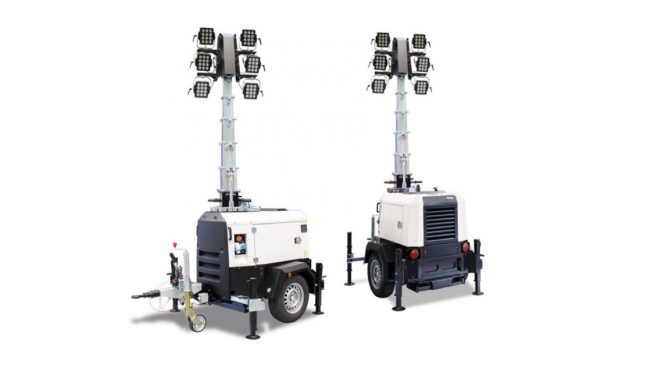For January’s blog Tim Benson, Chair of Powerful Thinking explores the world of tower lights – with tips for selecting the right light for your job and features to look out for, Tim factors in budgets and location requirements to help pinpoint the most fuel efficient model for your needs.
This month I want to explore the world of tower lights. Is choosing the right model an exact science or are they all broadly the same? Certainly, manufacturers like Trime have invested considerable time & money in expanding their product portfolio to include diesel, hybrid, solar & all electric models, so there is clearly some appetite for alternatives to diesel units.
Below I have set out some handy hints for selecting the right tower light for your job, together with a list of features to look out for:
A good starting point is to consider what size area you are trying to light. Is it a carpark, a BOH compound or an entrance gate? Most new models come with either four or six adjustable LED heads (lamps) operating at between 100 – 150W, although the Atlas Copco HILIGHT H6+ boasts four 350W lamps. Both the lamp configuration & the mast height (typically 8.5 – 9m) will affect the maximum area the tower light can illuminate. Units with four lamps will typically light an area of between 2,000 – 2,400sqm, whilst those with six will cover up to 3,800sqm. Where you are lighting large open areas, this increased coverage can reduce the number of units required, so it is worth checking coverage in the product specs.
Another useful thing to consider is where the tower lights are located on site. For large sites with multiple units, it can be time consuming having to manually operate each one, so some form of automation is a helpful function. Most new units come with a dusk-till-dawn sensor, which automatically turns the lamps on and off, subject to ambient lighting levels. Other models use a more basic timer function; whilst some can even be remotely controlled through the aux. remote start input and an App.
Cost of hire will always be an important consideration but it is also prudent to consider fuel efficiency. Things have come a long way since the advent of the first iteration of the VT1 with its metal halide heads (lamps) & its thirsty, noisy engine. The Trime EX-ECO unit is probably the most economical diesel model on the market, consuming only 0.47L/hour. With a 110L internal tank, it offers 230 hours runtime before needing to be refuelled. It further has the option of running directly off an AC feed.
Hybrid models, which run off battery, are an even more efficient solution & were certainly my first choice until recently. The Trime and BGG hybrids offer between 11 – 13 hours autonomy before the diesel engine automatically starts and runs for about three hours to recharge the lithium cells. For a 100% renewable solution, Trime & Prolectric offer a range of solar units with integrated PV panels that they say work all year round. To extend runtimes, some of the solar units offer a dimming option too. Both the hybrid and solar models have the added advantage of being silent running & produce zero tailpipe emissions during operating hours, making them ideal for campsites or shows in locations where overnight noise bleed is an issue.
However, as is often the case, there is a trade off between the more efficient electric models & their diesel counterparts. Firstly, the footprint of the Trime X-Solar tower light (3723 x 1784 x 2640mm / weight 1,523kg) means that only four can be loaded per truck, compared to 13 of the EX-ECO diesel units (2320 x 1380 x 2420mm / weight 920kg). This means higher emissions levels and increased costs associated with logistics. However, for long-term projects this may be less of an issue, as the environmental and fuel savings over time will mitigate these. Another issue worth raising here is that the hybrid & solar models do not include a 16A cee-form out, so cannot be used in generator mode, which from my point of view is quite a limiting factor. However, conversely some manufacturers of diesel units are downsizing the alternators in a bid to improve efficiency, the knock-on effect of which is that you cannot pull a full 16A from them, which can be frustrating. Finally, with many solar units, the masts have to be manually operated and they can be tricky to position because of their weight.
Clearly there is a lot to consider when choosing your optimum tower light. My suggestion is to weigh up the pros cons & not be dazzled by speculative claims of emissions busting, work the figures out for yourself! And to finish, for tower light hires, I wholeheartedly recommend both Illumin8 https://www.illumin8lights.co.uk & MHM http://www.mhmplant.com ”
Tim Benson’s blog first appeared in the Vision: 2025 January 2021 newsletter.Sign up to receive monthly event sustainability news, case studies and guest blogs direct to your inbox HERE.

